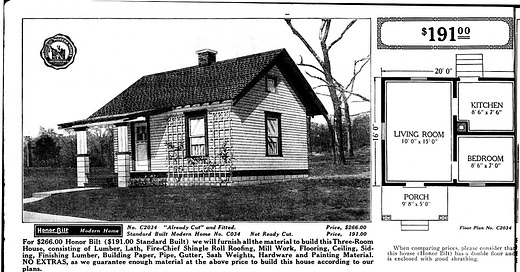Part 3: I am Going to Bring Back the Sears Home
What My Pilot for Mail Order Homes Looks Like
SERIES STRUCTURE
Part 1: The Case for Mail Order Housing
Part 2: The 4 Necessary Ingredients for Re-Launch of Mail-Order Housing
Part 3: What the Pilot for Mail Order Housing Looks Like
PART 3: WHAT THE PILOT FOR MAIL ORDER HOUSING LOOKS LIKE
All new ideas need a proof of concept, and this is particularly true of new construction and development models. Every generation has a new “this will totally change the construction industry” model, and traditionally they all fail. For better and worse, we have been building (and supplying) homes the same way for 140 years - through site-built stick framing.
The nature of housing is that it is expensive, and the industry is famously resistant to change, so testing new ideas can be incredibly capital-intensive. The other issue is that Silicon Valley is a graveyard of failed tech attempts to revolutionize housing (none bigger than the epic failure of Katerra). That’s a longer post for another day, but the main thesis, lifted from Devon Zuegel, is that tech exists in an almost completely unregulated world, where the brightest are freed to solve problems without constraint, and development, well, let’s just say, does not.
Thus, the two industries often work together like oil and water, and techies who think they can solve the problems in development often get their asses kicked after misunderstanding the constraints of human unpredictability, intense regulatory realities, and the ever-increasing politicization of housing.
So, let’s talk pilot. How do we prove this model? Given these constraints, how do we pull the sword from the stone?
Keep reading with a 7-day free trial
Subscribe to onHousing to keep reading this post and get 7 days of free access to the full post archives.




